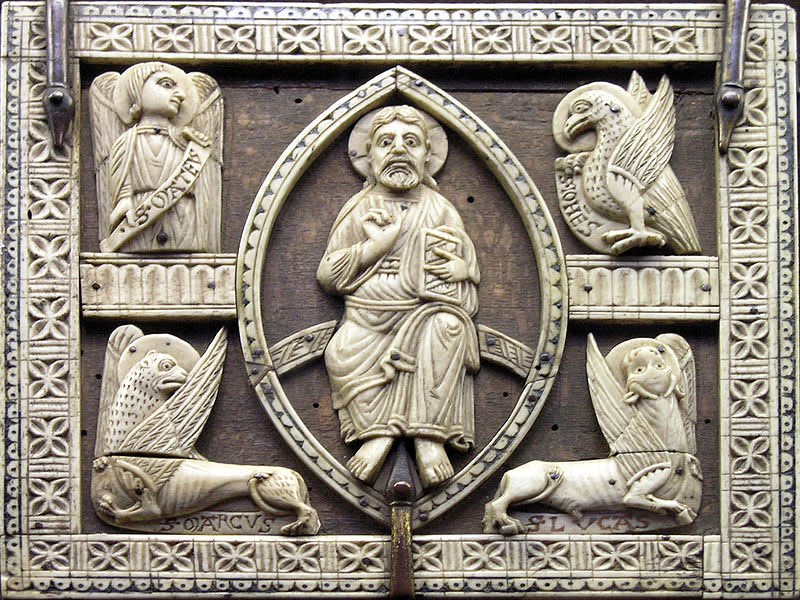
In Part 2 of our study on The Birth date of Jesus Christ, we pick up where we left off, with the significance of the king’s coronation tied to Rosh Hashanah, New Years Day and the head of Israel’s calendar. This depicts Christ as King of Kings presiding over all temporal, civil and sacred matters as the King-High Priest of Israel. As we have noted in prior posts on this Blood Moon Blog, the king’s coronation was framed in the heavens by Blood Moons surrounding the Birth of Christ. [read more] The Blood Moons of 5 Bc and 1 BC not only framed the birth of Christ but the Jan. 9, 1BC Blood Moon also marked the death of Herod. An example of the coronation tradition, which served to proclaim the birth of Jesus Christ as the King in the kingdom of Israel can be seen in II Kings 11: 2 Kings 11:12-14 And he brought forth the king’s son, and put the crown upon him, and gave him the testimony; and they made him king, and anointed him; and they clapped their hands, and said, God save the king. [13] And when Athaliah heard the noise of the guard and of the people, she came to the people into the temple of the Lord. [14] And when she looked, behold, the king stood by a pillar, as the manner was, and the princes and the trumpeters by the king, and all the people of the land rejoiced, and blew with trumpets: and Athaliah rent her clothes, and cried, Treason, Treason. The chronological alignment that we should recognize regarding the reigns of Judean kings being calculated from the New Moon on New Years Day, Rosh Hashanah on the Hebrew Calendar, coincides with the birthday of Jesus Christ. This alignment calculated from Tishri 1 to Tishri 1, is established in the celestial coronation ceremony of the promised seed, with a triple planetary union of Jupiter-Regulus marking the birth of Christ. The graphic below shows the King planet Jupiter, crowning the king Star-Regulus in Leo, resulting from Jupiter’s retrograde motion through Leo in 3-2 BC. This triple conjunction of “His Star” Jupiter and Regulus starting on September 14th, 3 BC, three days after the actual birth of Christ, are unmistakable signs in the heavens marking the long awaited arrival of God’s only begotten Son Jesus Christ. We have pointed out previously, how the dual significance of the Rev. 12:1-2 prophecy, applies not only to the birth of Christ, but to his victorious return also! Even as the heavenly signs specifically marked the birth of Jesus Christ, supporting the witness of God’s Word, so we expect to see similar signs in the heavens marking the Lord’s Return. As we have recognized in our study of the Blood Moon Tetrad 0f 2014-2015, the Blood Moons are key aspects of the heavenly signs that occur “before that great and terrible day of the Lord comes;” [Joel 2:28-32]. The Blood Moon Lunar and Solar Eclipses already seen in 2014, along with the Blood Moons and Solar Eclipses coming on the Lord’s Feasts and Holy days in 2015 are highly significant prophesies being fulfilled before our eyes, marking the end of days, leading to the victorious return of our Lord Jesus Christ.
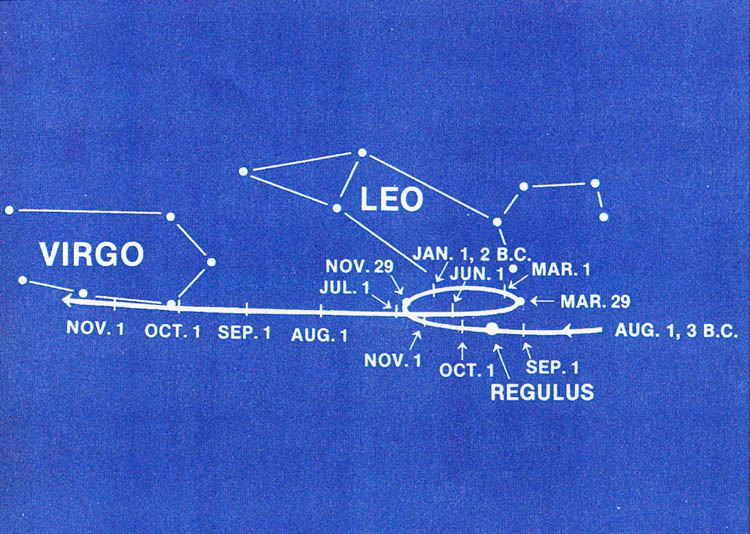
Even as all Israel rejoiced at the coronation of the King, so all creation will rejoice at the crowning of the King of Kings. There are 10 steps recorded in the king’s coronation here in II Kings 11:12-14, once he had been brought forth, the 7th of which is “the king stood by a pillar, as the manner was.” This 7th step in the king’s coronation procession corresponds to the 7th month Tishri on the Hebrew Calendar, marking the birth of Christ. 2 Kings 11: 13 above notes that the coronation ceremony took place in the Temple of the Lord, which is logical since the king was ordained and anointed of God. II Chronicles shows us this record in greater detail. 2 Chronicles 23:13 [13] And she looked, and, behold, the king stood at his pillar at the entering in, and the princes and the trumpets by the king: and all the people of the land rejoiced, and sounded with trumpets, also the singers with instruments of music, and such as taught to sing praise. Then Athaliah rent her clothes, and said, Treason, Treason. There has been conjecture as to the meaning of this pillar [*H5982 ammud]. However, the record in 2 Chron 23 puts this “pillar at the entering in,” and if this is entrance of the temple, then we have a reference to the Temple’s great ornamental pillars of brass called Jachin and Boaz. This agrees with the New Bible Dictionary which states: “The entrance to Solomon’s Temple was flanked by two gigantic bronze pillars, [I Kgs 7:15-22]. It was apparently by one of these that the king stood on ceremonial occasions [II Kings 23:3, II Chron. 23:13].” In II Chron. 34:31, King Josiah stood in his place (*H5977–omed) and made a covenant before the Lord to keep His commandments. The word translated “place” has the same Hebrew root [*H5975– amad] as the word “pillar” above.4 The King’s rule was blessed in the degree and to the order in which he kept the covenant of God’s Word in his rule, indicated in the names of the temple pillars. 1 Kings 7:21 And he set up the pillars in the porch of the temple: and he set up the right pillar, and called the name thereof Jachin: and he set up the left pillar, and called the name thereof Boaz. According to the New Bible Dictionary in reference to the significance of the names Jachin and Boaz; “the names may be the first words of oracles giving power to the Davidic dynasty: perhaps ‘Yahweh will establish (yakin) thy throne forever’ and ‘In the strength (beoz) of Yahweh shall the king rejoice‘.”5 Thus, as the kings of Israel stood in their place, by their pillar in the temple during the coronation ceremony, so the coronation of the King of kings, seen in the stellar announcement of the birth of Jesus Christ, also marked by one of the four celestial pillars of heaven. In the first phase of the Lord’s appearances on earth, fulfilling Rev. 12:1-2 in the birth of Christ, we find in the Virgo graphic below, the sufferings of Christ are emphasized indicating the primary purpose of his ministry to Israel, as the one time embodiment of the Passover lamb sacrifice for the sins of Israel. This is detailed in the graphic taking note of the intersection of the Ecliptic and the Celestial Equator. This intersection is one of the Four Corners, or literal Pillars of heaven, also called Cardinal Points which “square the circle” of the Ecliptic, or the circle of the zodiac. The intersection point is right at Virgo’s feet, marked by the New Crescent Moon opening the New Year on Rosh-Hashanah, with the birth of Jesus Christ. As the Celestial Equator extends to the horizon it marks the Star Spica [Al-Zemach], the branch and offspring of God the Father, while beneath Virgo’s feet it bisects the sign Libra. In the Hebrew Zodiac, Libra symbolizes the price of redemption being paid by the Lord’s sacrifice. This puts the focus on the purpose of Christ’s ministry to Israel, and the sufferings he had to endure to pay this price of redemption, not only for Israel, but all mankind. The woman’s promised seed is called “the branch” in the following references; [Jer. 23:4-6, Jer. 33:14-18, Zech. 3:8].
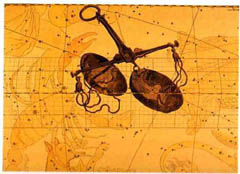
There are a number of legal requirements that the Lord Jesus Christ had to fulfill if every jot and tittle of the Law was to be upheld as Christ stated, [Matt. 5:18]. In order for Jesus Christ to fulfill the OT law as the legal sacrifice for Israel and all mankind, he had to abide by all stipulations of the “ordinances of the Passover,” [Num. 9:12] as stated in God’s Word. Without the shedding of blood there is no remission of sin, [Heb. 9:22] and only Christ had the sinless and innocent blood that qualified as the perfect sacrifice to redeem mankind. Even Judas after betraying Jesus confessed: “I have sinned in that I have betrayed the innocent blood;” [Matt.27:4]. This condition is clearly stated in Exodus 12:5, as a lamb without blemish, [I Pet. 1:18-19] along with the important truth that it had to be a lamb of the first year. If these conditions were not met according to the standards of Scripture, then those partaking in the Passover would be cut off from Israel; [Ex. 12:15]. Even more critical was that Jesus himself had to fulfill all these conditions to the last detail, or mankind would remain in the sinful unredeemed state of us all, before the liberating work of the Redeemer of mankind was “finished,” [John 19:30]. In this study we will focus on this important Biblical condition and regal requirement of the OT Law, that the Passover lamb had to be a male lamb of the first year, in order to redeem Israel. In the case of Jesus Christ, he did not fulfill this requirement until he became an adult male of full age starting at 30 years old. The gospels record that Jesus was recognized by John the Baptist as the “Lamb of God, who takes away the sin of the world,” [John 1:29, 36]. The truths told by the sign of Libra, or the balances, tell us all men fall short of Jesus Christ when it comes to paying the redemption price for their brothers [Ps. 49:7-15], because all men have been weighed in the balances and found wanting, except Jesus Christ; [Rev. 5:9]. This truth we find depicted in the graphic below, as the celestial equator bisects both Libra’s balances along with the Star Spica.
Sunset as seen from Palestine on September 11th 3 BC, with the Sun in Virgo and the Moon at her feet.6
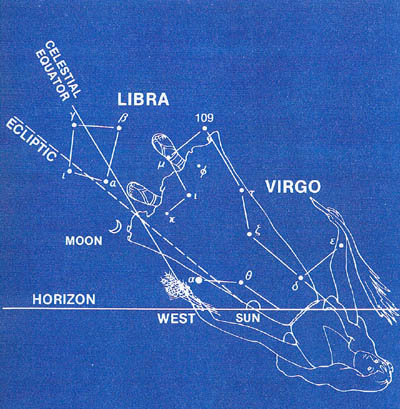
Isaiah 4:2 contains some wonderful details linking directly into the stars of the Constellation Virgo. Isaiah 4:2-3 2 In that day shall the branch of the LORD be beautiful and glorious, and the fruit of the earth shall be excellent and comely for them that are escaped of Israel. 3 And it shall come to pass, that he that is left in Zion, and he that remaineth in Jerusalem, shall be called holy, even every one that is written among the living in Jerusalem: The word “beautiful” in verse 2 above corresponds to the meaning of the star “Zavijava” in Virgo, a true trait of the promised seed of the woman. It is truly wonderful to witness the inborn symmetry of God’s Word, flowing from the divine revelation of the Creator, as the pattern narrative of the Stars and the Scriptures unfolds in unison before our eyes. The 2nd phase of the Rev. 12:1-2 prophecy, does not pertain to the sufferings of Christ, but to his Glorious return to install his Millennial Reign, inheriting the throne of the Davidic dynasty marked by the Temple pillars Jachin and Boaz. We will see more on the sufferings and glory of the Lord as it applies to the dual significance of Rev. 12:1-2 later in this study. The “glory” of the promised seed referred to above in Isa. 4:2 is also foretold in one of the decans of Virgo known anciently as Coma, the desire of the nations. This was prophesied in God’s Word in Haggai 2. Haggai 2:6-7 6 For thus saith the LORD of hosts; Yet once, it is a little while, and I will shake the heavens, and the earth, and the sea, and the dry land; 7 And I will shake all nations, and the desire of all nations shall come: and I will fill this house with glory, saith the LORD of hosts. At this center point in history, at the celestial pillar of the autumnal equinox, with the Moon at Virgo’s feet, with the setting of the star Spica–Al Zemach, the moments of the birth of Jesus Christ were framed in the heavens. This was followed 3 days later, by the first celestial union of the triple coronation ceremony that occurred, beginning in the first Jupiter-Regulus Conjunction in Leo, on Sept. 14th 3 BC. This occurred during the Feast of Tabernacles, which along with Passover divided the sacred calendar in half, reminding us of the luni-solar year evident in the cycle of Jubilees. This also is reflected in the Blood Moon Tetrad of 2014-2015, with these Blood Moons and Solar eclipses marking the holy feasts, with increasing intensity as we approach the end of days leading to the victorious return of Jesus Christ. Since a Blood Moon Tetrad is completed in 2015 as a celebration of Jubilees on the Hebrews sacred Calendar, we should pay special attention to the crescendo that is being reached, in the compiled Blood Moons and heavenly signs, on the Lord’s feasts and holy days, filling the headlines of our current events.
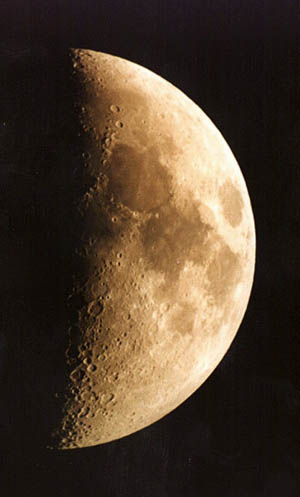
The Feast of Tabernacles was the 3rd of the great annual feasts of the Hebrew sacred calendar, beginning on the fifteenth of the 7th month, at the height of the full Moon. It determined the start, and closed the sacred Sabbatical cycle, while marking the agricultural seasons. Coming during the 7th or most sacred month with its Moon at full strength, shows us another mark of seven in the temporal order of this feast. We can see that the cycles of the Moon were designed into the timing of feasts from the start by God, so it is interesting to see the message of the Blood Moon Tetrads, not only related to the feasts of Israel’s sacred calendar, but also the harvest seasons and resulting crops. The offerings of the people in recognition to the Creator were also directly linked, since they gave the first-fruits of all their increase to Honor His graceful abundance. Each of the offerings associated with the Feast of Tabernacles were marked also by the number 7, indicating its completion, satisfaction and spiritual perfection; 70 bullocks, 14 rams, 98 lambs, equaling 82 sacrifices [26 x 7] plus 336 [48 x 7] tenths of ephahs of flour for meat offerings}.7 Thus, man is to share of his abundance in honor and respect to God according to the same spiritual standard of abundance by which he had received it from the Creator, accordingly living his life in honor and praise to his Heavenly Father. As God’s people honor and Praise The Almighty, and the works of His Hands, we can share in the abundance that He has made available for His people. This highlights another purpose of the Blood Moon Tetrads marking the Hebrew feasts over the last 200 centuries, since these feasts are designed to Honor the Almighty Creator of Heaven and Earth, from Whom all blessings flow. Even in the curse of the ground that resulted from Adam’s fall; [Gen. 3:17-19] men would suffer in the sweat of the labor on our faces as we eat of the ground in the sorrow of our days…but as we stay obedient to God and His ways of righteousness, we will reap a harvest not only in this world, but also eternal rewards in glory. Alfred Edersheim comments further on the significance of the number seven in his book; The Temple, where he states: “What the seventh day, or sabbath was to the week, the seventh month seems to have been to the year.”8 Thus it would follow that, as Pentecost was to Passover in that it followed it by fifty days (7×7+1), so the Jubilee followed in annual cycles. Leviticus 25:8 relates the “7 Sabbaths of years” to the 50th cycle of the Jubilee, which fell on the Day of Atonement, or the 10th day of the holiest seventh month of Tishri. In the same way that liberty was proclaimed in the Jubilee, throughout all the land and to all its inhabitants [Levi. 25:10], so Jesus set at liberty them that were bruised, while proclaiming the acceptable year of the Lord at the opening of his ministry during a Jubilee celebration. The Jubilee celebration takes place in a single year, every 50th cycle, immediately following 7 Sabbatical cycles, marking the combination of 2 years for resting the land, with slaves freed and all debts cancelled. As Jesus proclaimed liberty in the land for Israel, so he will free all mankind from the bondage of sin and captivity in the Grand Jubilee of all time, in the harvest at the end of the world. Here we find evidence of Jesus’ recognition that he was the Lamb of the first year, because his quotation from Isa. 61 opening his ministry, makes specific reference to “the acceptable year [singular] of the Lord.” If Jesus were to complete the requirements of his assignment from the Heavenly Father, he would have to finish it within this acceptable year. This, allows no room for traditional teachings that the length of Jesus’ ministry was 3 years, because if so, then this critical “ordinance of the Passover,” coinciding with the Jubilee cycle cannot be fulfilled and mankind would remain unredeemed. Below we find that Jesus quoted Isaiah 61 very precisely to initiate his ministry to Israel. In fact, his quotation was left incomplete! The entire quote of Isa. 61:1-2, as recorded in Luke 4:18-21, is seen below. [Isa. 61:1-2]. 61 “The Spirit of the Lord God is upon Me, Because the Lord has anointed Me To preach good tidings to the poor; He has sent Me to heal the brokenhearted, To proclaim liberty to the captives, And the opening of the prison to those who are bound; 2 To proclaim the acceptable year of the Lord, And the day of vengeance of our God; To comfort all who mourn Luke 4:18-21 New King James Version (NKJV) Records Jesus quotation of Isa. 61 as he announced the opening of his ministry.
18 “The Spirit of the Lord is upon Me, Because He has anointed Me To preach the gospel to the poor; He has sent Me to heal the brokenhearted,[a] To proclaim liberty to the captives And recovery of sight to the blind, To set at liberty those who are oppressed; 19 To proclaim the acceptable year of the Lord.”[b]
20 Then He closed the book, and gave it back to the attendant and sat down. And the eyes of all who were in the synagogue were fixed on Him. 21 And He began to say to them, “Today this Scripture is fulfilled in your ears.”
Why did Jesus cut this Isa. 61:2 quotation off in mid-verse? Because “the Day of vengeance of our God,” refers to events in the Book of Revelation when the wrath of the Almighty will be revealed on the ungodly, which is still future. Here is an awesome example of Jesus “rightly dividing” God’s Word. The comma separating these two phrases in this verse represents the Age of Grace that we have been living in for the last 200 centuries. This Gap of Salvation between the sufferings and glory of the Lord, is perhaps best understood in I Peter 1. 1 Peter 1:9-12 New King James Version (NKJV) 9 receiving the end of your faith—the salvation of your souls. 10 Of this salvation the prophets have inquired and searched carefully, who prophesied of the grace that would come to you, 11 searching what, or what manner of time, the Spirit of Christ who was in them was indicating when He testified beforehand the sufferings of Christ and the glories that would follow. 12 To them it was revealed that, not to themselves, but to us[a] they were ministering the things which now have been reported to you through those who have preached the gospel to you by the Holy Spirit sent from heaven—things which angels desire to look into.
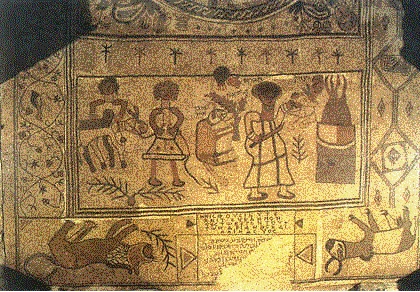
Not the Prophets or the angels themselves knew about the Great Mystery of the Age of Grace [Rom. 16:25-27, I Cor. 2:7-10], that was kept secret by God since the world began. Christ’s ministry to Israel preceded the Age of Grace, which opened on the Day of Pentecost in 28 AD, when the Holy Spirit was first poured out on mankind and the Apostles first spoke in tongues. How do we arrive at this date of 28 AD? Very simple, we merely count forward from Sept. 11th 3 BC at the birth of Christ-30 years, to Christ opening his ministry to Israel. This brings us to 27 AD, then allowing a year+ [70 weeks] for the Lamb of the first year to complete his work, which he finished in 28 AD. It is interesting to observe that there are thirty Jubilees that bring us from the Exodus to the opening of Christ’s ministry, when opening the scroll to Isa. 61:2, Jesus certified the “acceptable year of the Lord” in a 7-fold prophecy, (Lk. 4:18-21). This fits neatly with the truth that in fulfilling the O.T. Law, Jesus as the embodiment of the Passover male lamb of the first year [Exod. 12:5), Jesus was in the first year of his manhood according to Hebrew reckoning, starting at 30 yrs old. [Luke 3:23] This period of the Lamb of God in his first year is clarified even further by the Prophet Daniel. In Daniel 9, a specific period of 70 weeks was foretold; [Dan. 9:24] and decreed by God for Jesus to fulfill the Messianic redemption of his ministry to Israel. Here Jesus was crucified, resurrected, and ascended, exploding the myth that his ministry lasted any time beyond 2 years. This however, is not the only Biblical or historical evidence of Jesus’ birth on 9/11/3 BC, or regarding the length of his ministry. We must also consider evidence concerning the construction time to build Herod’s Temple, along with the Rule of Tiberius Caesar of Rome. History tells us that Tiberius’ rule [Luke 3:1], over the Rome Empire began in 12 AD, but he shared a co-regency with Augustus Caesar who died in 14 AD. This makes Tiberius’ 15th year of rule-26 AD, which was Jesus’ 29th year. 9 As the Bible states: he was “about 30 years of age.” Secondly, regarding the dating of the construction of Herod’s Temple, [John 2:20, read more] states; “46 years was this Temple in building…” John 2:20 was spoken at Passover in the month Nisan of the Hebrew Calendar, which calculated time regarding sacred matters. The construction time of the Temple qualifies as a great example of a “sacred matter.” According to dates provided by Josephus, construction began on the Temple in 19 BC, followed by 46 years, putting us in the week following the Wedding at Cana, [Jn. 2:1-11, 13 to 3:21] when Jesus cleansed the Temple [Nisan 14th-21st], or April 10th to the 17th in 27 AD. 10 By the time Jesus completed the work of his ministry, he was 31, which fits neatly in the time frames set forward above in God’s Word. Obviously this is 4-5 years short of the traditional, 32-33 AD dating of Christ’s crucifixion, prior to the Blood Moon Tetrad of 32-33 AD. Thus with all these historical and Biblical time markers in agreement with each other and established on Biblical truth, a strong case is presented contrary to traditional crucifixion dates of 32-33 AD, with a 3-year ministry of Jesus Christ. As a result, using this Blood Moon Tetrad to mark the crucifixion of Jesus Christ is not consistent with, with the Scripture narrative on the subject.
Footnotes
5. New Bible Dictionary
6. Jesus Christ Our Promised Seed, picture credit; p.71
7. The Temple, Alfred Edersheim
8. IBID
9. A Harmony of the Gospels-Chronology of the Life of Jesus Christ, ppg. 2, 12
10. Josephus, Wars I. xxi, 1

